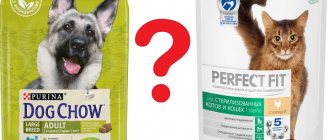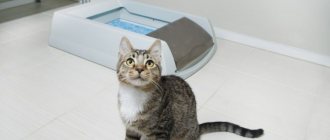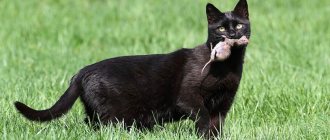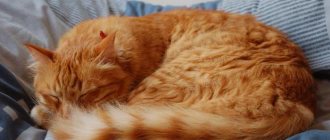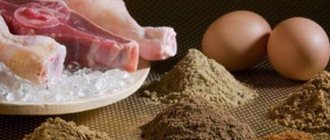Lack of habit
Most often, a situation where a cat ignores dry food occurs if the animal was not accustomed to this product initially. At the same time, one should not conclude that the cat “considers” it to be unsuitable food; it’s just that, unlike wet foods, dry food smells different and has an unusual consistency.
All you need to do is get your pet used to a dry diet, starting with feeding food that the cat will eat with pleasure (this can be either canned pet food or a natural diet), and gradually adding dry food pellets to it.
At first, they should make up no more than 15-20% of the total serving volume, and then their number is gradually increased until complete replacement. On average, such a smooth transition takes one to two weeks.
If the cat is capricious and leaves dry food granules in the bowl, eating everything else, then you can act harshly by simply depriving the pet of any other food. A hungry animal will sooner or later start eating what is given.
Kitten doesn't like dry food
This happens if the ready-made industrial diet is not complete enough for a small predator. Animals determine the composition of food by smell, and the most significant for them is the aroma of meat or fish, as well as the corresponding fats. If a kitten does not feel these components in food, then it will refuse it for a very understandable reason: such food is not suitable for it.
Therefore, when choosing dry food, pay attention, first of all, to the number of meat components in its composition; they should form the entire basis of the diet, that is, occupy at least the first five places in the list of ingredients. You can get a complete picture of what dry cat food should be like from this article.
Eating disorder
The reason why a cat does not eat dry food may be constant feeding of other foods. Many owners like to treat their pets to wet diets, considering them just a treat or treat. At the same time, it is a food that contains enough calories to curb your appetite.
Usually, cats spoiled in this way begin to demand something tasty, ignoring the dry food in the bowl, and are so insistent that the owners give their pet a snack again and again, and then worry about giving up the dry food.
Another fairly common situation is non-compliance with feeding standards. Dry food pours out in a heap, and since cats tend to approach the bowl 10–15 times a day and eat a little, the owners, without noticing this and constantly contemplating a full bowl, conclude that their pet is not eating .
One has only to determine and weigh the daily requirement to the nearest gram, and it turns out that the cat copes with it perfectly. It is best to pour half a serving in the morning and half in the evening, then it will be even easier for you to determine how much your pet has eaten.
How to convince a kitten that dry food is good?
If it is known that the kitten’s dislike for dry food is not associated with ill health, then it is quite possible to accustom the small animal to eating this product. This requires patience and persistence.
- First of all, you need to dilute your usual food in small portions. If the kitten has just been fed mother's milk, then the granules must be soaked in water or milk. If this is an older cat, then you can soak the food in some other soft food he prefers.
- If you can see that the kitten happily absorbs the mixed food, then you can increase its share in the food.
- After about 5-7 days, it is worth starting to gradually add food in a dry, not soaked, state.
- Having seen that your pet eats what was offered, the next day you should try to give him only one dry food. If the kitten refuses, you still need to feed it the usual food for a while with the addition of soaked food. Then try again to give him only dry food.
Accustoming a kitten to dry food is an individual matter; here you need to monitor the pet’s reaction, be patient and attentive. This is best done by someone who loves their cat and wishes only the best for him.
Physiological reasons for refusing dry food
Older animals, and this sometimes happens to young ones, may refuse dry food due to problems in the oral cavity. They experience pain when chewing granules and, in order to avoid it, do not approach the bowl, but at the same time they feel hungry and ask to eat. You can examine your pet’s mouth and, if you notice reddening of the gums (normally they are pale pink), loose teeth with signs of rotting, consult a veterinarian.
Cats may not eat dry food if it has gone bad. A person is not able to smell rancid fat, but cats smell it perfectly, and instinct tells them to refuse food that can cause poisoning. Store dry food in a cool, dark place in an airtight container or tightly wrapped bag, and never use expired food.
A short-term refusal of dry food and, which is very important, from any food in general, can also happen for other reasons related to external factors. For example, in very hot weather, many animals lose their appetite, it can also decrease for several days during estrus, and during severe stress it almost always disappears. In the latter case, the period of refusal to eat can last several days. Stress in cats is caused by any changes in the environment - moving to another place, the arrival of a new family member or pet, renovations in the apartment, etc.
Although loss of appetite due to stress is a natural phenomenon, this does not mean that it should not be addressed, as long-term stress is detrimental to a cat’s health. Therefore, try to provide your pet with a sense of security; cats get used to changes more easily if you temporarily limit their living space to one room, where “strangers” will not have access and where the animal, in a calm environment, will gradually become convinced that there is no danger.
Why does your pet refuse to eat?
If you are confident in the quality of the product you are using, do not rush to change it, even if your cat suddenly begins to eat poorly.
Many owners begin to panic: they try options from other manufacturers, then another type, for example, canned food or natural food. Such leapfrog can only do harm and further discourage the animal’s appetite. Perhaps the cat is simply capricious because you often pamper it with treats (cat treats, food from your table). The cunning animal immediately realizes that it is not necessary to eat boring granules: all you have to do is meow pitifully and the owner will give you a “yummy” treat.
If your cat is not a good eater of dry food, we recommend eliminating all snacks and treats, especially when you are just starting to introduce him to a new type of food. As a last resort, you can skip a couple of feedings: usually after this, even the most capricious ones begin to crunch pellets briskly.
Do you want to know why an animal might not want to eat it? This may happen for the following reasons:
- The cat doesn't eat dry food because she simply doesn't like it. Try changing its brand, not necessarily to a more expensive product. She might be happy to eat the budget option. It all depends on your pet's personal taste preferences. You should not buy large quantities at once. Take a little at a time until you find exactly the one your cat likes.
- The cat stopped eating dry food, although she used to eat it with appetite - maybe she was just tired of the monotonous food. Try giving her canned fish or any liquid food. Pamper your pet with pates and meat purees. The cat refuses to eat dry food, give it wet food. Change the foods on the menu as often as possible, and your pet will always eat with pleasure.
- The cat does not eat dry food well because he does not like the smell and taste. This often happens if pet owners like to pour more food into a bowl than the animal can eat in a day. Over time, the product becomes damp and loses its aroma.
- The cat ate it for a month, and now categorically refuses to do it. Pet owners who prefer to make bulk purchases may encounter a similar problem. By buying packages that are too large, you run the risk of eventually getting a product that is unusable. Due to long-term storage, it can absorb moisture and foreign odors, which will significantly deteriorate its taste.
- Very often, cats refuse to eat from dirty dishes. Wash bowls every day. They should always be dry and clean.
- The lack of clean drinking water nearby can prevent a cat from weaning itself from eating dry food. If food gets into it, the animal may refuse to drink. Lack of water in the body can lead to disruptions in the digestive system, which can cause loss of appetite.
- The cat may not eat because he is small and is simply not used to such food yet. It will take patience and time to teach him to do this.
- You fed the animal with food you prepared yourself, and now you have decided to switch it to another type of food. This may cause the pet to protest, manifested by refusing to eat.
- Refusal not only from dry food, but also from any other food can be a symptom of various diseases. Perhaps your pet is sick and needs veterinary care.
There are many reasons that can cause a cat to refuse pelleted food. Some of them are associated with natural physiological factors, others are not normal and can threaten the cat’s life.
Diseases
Many diseases can provoke a refusal of dry food. The owner needs to pay attention to the general condition and behavior of the animal. If the cat is interested in the food, sniffs it and tries to eat, but at the last moment turns away or spits out the pellets, this may indicate damage to the gastrointestinal tract or the presence of a foreign body or neoplasm in it.
With dermatological diseases affecting the area around the mouth, the cat retains its appetite, but cannot eat due to pain
Pathology can affect not only the intestines or mucous membranes of the esophagus and stomach, but also the oral cavity. Animals often refuse dry food due to toothache. At first it causes discomfort, but the cat continues to eat. Later, as the pain intensifies, a kind of reflex arises, and the pet turns away from food.
We suggest you read: The cat shakes its ears a lot, reasons and what to do
Interest in wet food and natural products can be maintained: softened food causes less discomfort. With dental diseases, a pet may chew on hard objects in order to independently get rid of the source of pain. Most often, an injury or signs of pathology can be detected by visual examination, but in some cases an x-ray is required.
Tartar can lead to the loss of fangs, so regular brushing with a special brush is recommended.
New growths in the oral cavity can cause no less discomfort. During eating, they can be injured by teeth or hard granules. In some cases, this can cause bleeding. Most often, tumors can be detected independently. They can be soft, hard, movable, fixed, white, black, etc.
Depending on the location of the tumor, the animal may experience increased salivation and difficulty swallowing
With diseases and damage to the musculoskeletal system, a cat may refuse dry food and other food while maintaining appetite due to limited mobility and pain. In such cases, the animal experiences severe discomfort, meows, limps, drags its paws or cannot rise at all, defecates under itself, etc. The condition is one of the most dangerous, so it is important to carefully deliver the cat to the veterinarian without causing it additional pain.
In some cases, the animal completely refuses dry food. It has no interest in it or other food. The pet is hungry, but at the sight of food it immediately turns away or leaves. This symptom may accompany the following diseases and conditions:
- Intoxication. Poisoning is accompanied by rapid heartbeat, nausea, vomiting, digestive disorders, fever, etc. In severe cases, loss of orientation in space occurs. In a critical condition, the cat stops reacting to what is happening, and the body temperature drops. Possible failure of internal organs. In case of mild intoxication, after the poisoning is removed, the condition returns to normal without additional intervention. If the cat’s health deteriorates significantly, the cat is fed through a tube and given intravenous infusions to prevent dehydration.
- Lipidosis. The disease is characterized by excessive accumulation of fat in the liver. The animal may eat poorly or completely refuse food for a long period of time (2-4 weeks or more). The cat quickly loses weight, and the ribs, breastbone and hips become visible. The animal is worried about digestive disorders and jaundice. In case of lipidosis, appetite must be corrected as part of general therapy, since irreversible processes often begin to occur in the body.
- Internal injuries. The main signs of illness are hidden bleeding, swelling and severe pain. If the cat's gastrointestinal tract is damaged, blood may be detected in the stool. In the absence of severe exhaustion, the animal’s condition returns to normal on its own after treatment.
If the tissues of the urinary system have been injured, blood impurities or solid clots will be present in the urine; indirectly, color allows you to determine the location of damage - Infections. The reason for refusing dry food can be both gastrointestinal lesions and, for example, cystitis. In this case, poor appetite is associated with intoxication of the body by bacteria and their decay products. The animal definitely needs treatment, even if the symptoms have weakened or disappeared without treatment. Improvement in condition may indicate that the disease has become chronic.
- Gastrointestinal pathologies. The pet does not eat well or refuses dry food due to inflammation and pain in the abdomen, as well as nausea. If an animal eats both pellets and natural products, it may choose the latter. Foods that are high in liquid cause less pain due to their softer texture.
When feeling nauseous, your cat will often lick its nose. - Disorders of the central nervous system and brain. Most often this is observed with injuries. Appetite problems are associated with impaired transmission and recognition of nerve signals. As a result, the cat does not feel hungry while the body needs energy and nutrients. Treatment is mandatory; if necessary, the pet is fed through a tube.
- Helminthiasis. Infection with worms can occur through eating raw meat, contact with other animals, or accidentally ingesting parasite larvae along with insects, soil or water. With mild helminthiasis, weight loss, deterioration in general health, and mucus and blood in the stool are observed. Larvae or whole worms may be found in natural secretions and vomit. In severe cases, worms cause intestinal obstruction. After taking anthelmintics twice, the symptoms disappear; only animals in critical condition need additional correction.
- Inflammatory processes that accompany acute and chronic diseases. Deterioration of appetite can occur with any pathology due to the active functioning of the immune system. Most of the energy is spent by the body on eliminating inflammation, so the pet feels weak and loses its appetite.
- Intestinal obstruction. Refusal of dry food is associated with blockage of the gastrointestinal tract and the impossibility of normal movement of food and feces. In such cases, the cat experiences pain. With partial obstruction, the animal is bothered by bloating and diarrhea, with complete obstruction - constipation. Nausea appears. Without help, the pet may die. After normalization of the condition, the cat gradually returns to a normal diet.
We invite you to read: After sterilization, a cat asks for a cat and continues to mark: reasons for how to help your pet
Partial refusal of dry food and selectivity may be caused by visual or olfactory impairments. In this case, this is due to the unattractiveness of the food. Cats navigate by sight and smell, so if they lose their senses, they may suffer from poor appetite. If the situation does not improve after normalization of the pet’s condition and a course of therapy, owners are advised to use additional tricks to increase the attractiveness of the food.
Health problems
Complete refusal of any food, accompanied by lethargy, discharge from the eyes or nose, vomiting or diarrhea is a very alarming sign that may indicate a serious illness. Even loss of appetite in itself in a general depressed state without any other obvious symptoms is a reason to consult a veterinarian. This is exactly the case when it is better to play it safe than to waste time. True, we repeat, we are talking about a complete refusal of any food, and if the cat does not eat only dry food, but at the same time eats treats with pleasure, then everything is in order with its health, and you only need to establish a normal feeding regime.

